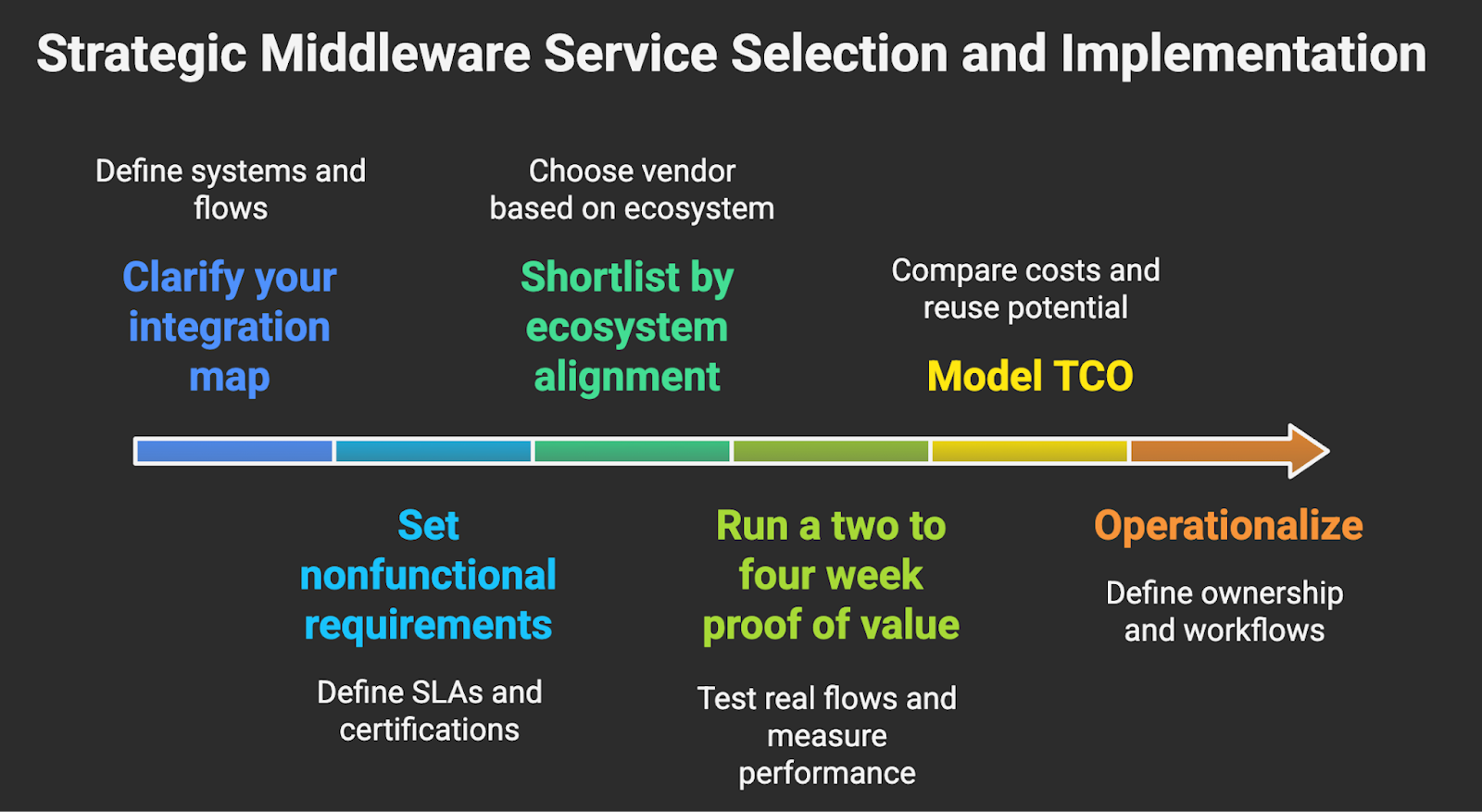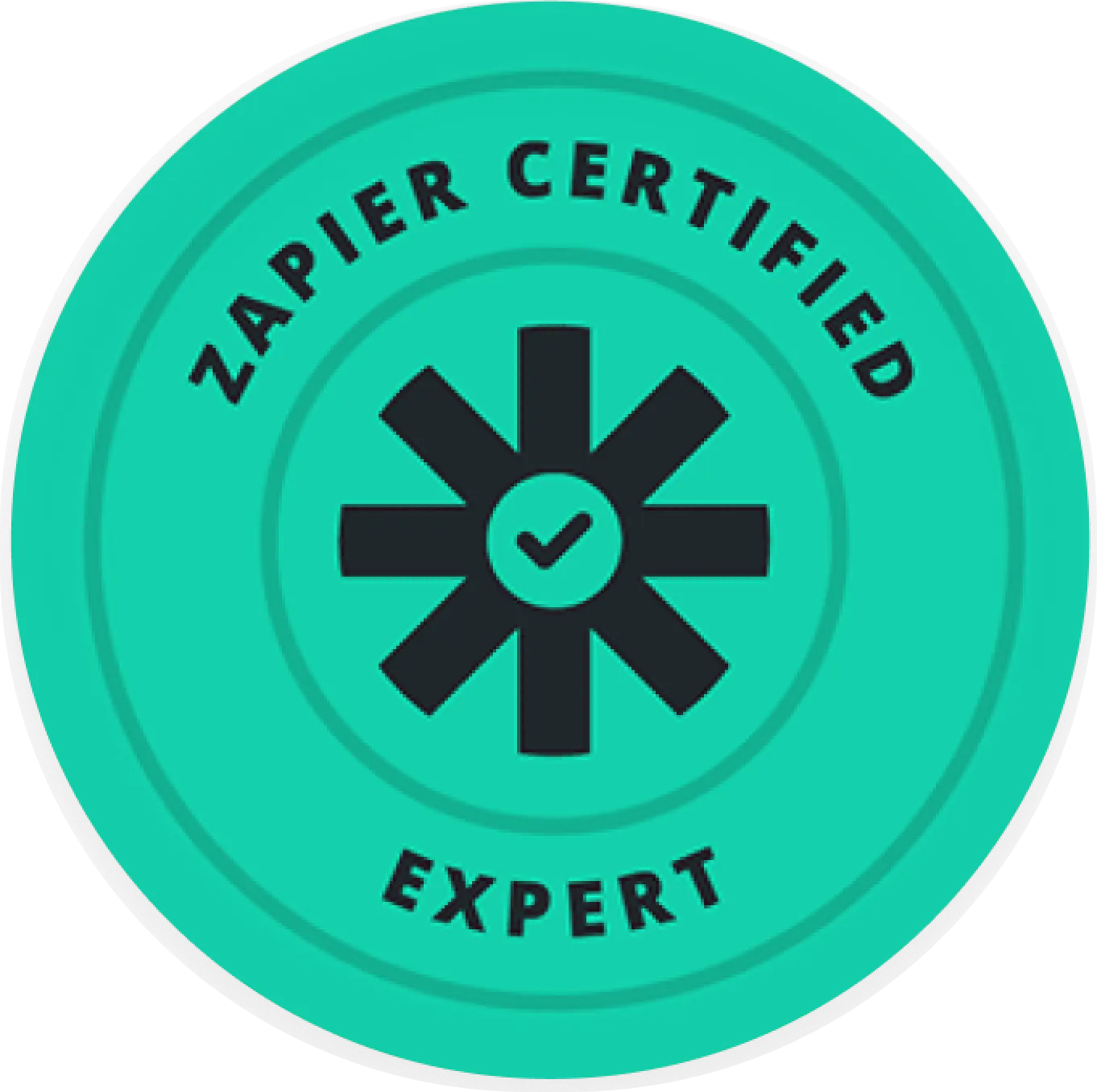Middleware as a Service, often delivered as an integration platform, connects your apps, data, and services so information flows reliably across your business. This article defines what MWaaS is, how it enables middleware integration across cloud and on premises systems, and where it fits versus direct APIs.
You will find a practical view of benefits, selection criteria, and a short framework to evaluate vendors. We also clarify middleware versus APIs with a quick comparison table and share how Makeitfuture can help you deliver measurable ROI from your first integration use cases.
WHAT IS MIDDLEWARE AS A SERVICE (MWAAS)?
MWaaS is a cloud delivered integration fabric that provides connectors, data transformation, workflow orchestration, security, and monitoring to link disparate systems at scale. In practice, most organizations consume MWaaS through an integration platform as a service, API management, and event streaming services working together. Examples include platforms like MuleSoft Anypoint, Boomi, Workato, Azure Integration Services, AWS Integration services, and Confluent Cloud, each covering part of the integration stack. This aligns with the widely used definition of iPaaS as a cloud service enabling integration of applications and data across environments, a core MWaaS pattern.
Because it is delivered as a service, MWaaS offloads infrastructure management and provides elastic capacity, automated updates, and pay as you use pricing, characteristics formalized by NIST’s cloud service model definition.
HOW MIDDLEWARE AS A SERVICE ENABLES INTEGRATION
MWaaS centralizes the building blocks you need to connect systems quickly and safely. In a typical flow, the platform authenticates to each system, transforms data between schemas, applies business rules, and delivers messages or API calls with retries and monitoring.
- Connectors and adapters. Prebuilt connectors reduce custom code to link CRM, ERP, data warehouses, payment gateways, and more. For example, Boomi and Workato provide large connector catalogs to accelerate delivery (vendor product pages that illustrate breadth of connectors).
- Protocol and data mediation. MWaaS bridges REST, SOAP, gRPC, JDBC, SFTP, and message queues, and maps between JSON, XML, CSV, and Avro. This implements patterns such as message translator and content based router, proven integration patterns used across the industry (Enterprise Integration Patterns, the seminal reference for integration design patterns).
- Orchestration and workflow. Visual flow designers and serverless workflow engines sequence steps, branch logic, and manage long running processes. Azure Integration Services combines Logic Apps, API Management, Service Bus, and Event Grid to orchestrate such flows (Microsoft documentation, an overview of the reference architecture).
- Event streaming and async integration. Event buses and streaming platforms decouple producers and consumers, reducing coupling and improving resilience. Services like AWS EventBridge or managed Kafka in Confluent Cloud enable pub or sub at scale (AWS EventBridge documentation and Confluent Cloud docs, authoritative product docs).
- API lifecycle and governance. API gateways expose consistent interfaces with authentication, rate limits, and versioning, while developer portals simplify consumption. Apigee, AWS API Gateway, and Azure API Management are common choices (Google Cloud Apigee product page, primary documentation for API lifecycle tooling).
- Security by design. Centralized policies enforce OAuth 2.0, OIDC, mutual TLS, data masking, and secrets management. Align policies with OWASP API Security Top 10 to reduce common attack vectors (OWASP API Security Top 10, the leading security guidance for APIs).
- Observability and SLAs. Built in logging, metrics, tracing, and alerting help teams detect and resolve issues quickly. Many platforms support OpenTelemetry to standardize telemetry across tools (OpenTelemetry documentation, the open standard for telemetry).
Example. You need to sync orders from Shopify to NetSuite, notify the warehouse, and update customers. With MWaaS, you use a Shopify connector to capture orders, transform payloads to NetSuite’s schema, call the NetSuite API, publish an event to the warehouse topic, then trigger transactional emails. Retries, error handling, and dashboards come out of the box.

BENEFITS OF INTEGRATING WITH MIDDLEWARE AS A SERVICE
You are buying acceleration, reliability, and governance. The right platform lets small teams deliver integrations safely and repeatably, without rebuilding plumbing each time.
- Faster time to value. Prebuilt connectors, mappings, and templates reduce build time from months to weeks, often from weeks to days on repeatable patterns. Forrester TEI studies of leading iPaaS vendors consistently report compressed delivery timelines and positive ROI, which matches what we see in the field.
- Lower total cost of ownership. No servers to manage, fewer custom scripts to maintain, and elastic capacity you pay for only when used, consistent with the inherent cost model of cloud services (NIST SP 800-145, cloud characteristics that drive TCO savings).
- Resilience and reliability. Built-in retries, dead letter queues, and idempotency controls reduce data duplication and failures, echoing best practice integration patterns.
- Security and compliance at scale. Centralized policies, audit trails, and enterprise identity integration simplify compliance with SOC 2 and ISO 27001 controls.
- Scalability when you need it. Burst to handle peak events, then scale down automatically, common in managed event and API services (AWS and Azure integration service docs, capacity and scaling guidance from platform vendors).
- Governance and reuse. A shared library of connectors, transformations, and APIs increases reuse and enforces standards, reducing shadow IT and one off integrations.
- Operational visibility. End to end tracing and dashboards cut mean time to detect and resolve incidents, especially with OpenTelemetry compatible pipelines
- Future proofing. Support for event driven architectures, OpenAPI and AsyncAPI definitions, and modern protocols keeps you aligned with modern integration practices (OpenAPI and AsyncAPI official websites, widely adopted interface definitions).
HOW TO CHOOSE THE RIGHT MIDDLEWARE SERVICE FOR YOUR BUSINESS
Pick the platform that fits your architecture, team skills, and compliance needs. The best way to decide is to run a short proof of value on your top use cases, instrument it, and compare outcomes.
- Clarify your integration map. Inventory systems, data domains, and critical flows. Classify patterns, real time APIs, batch ETL or ELT, and event streaming.
- Set nonfunctional requirements. Define throughput, latency, availability SLAs, data residency, and required certifications, such as SOC 2, ISO 27001, or sector standards (AICPA SOC 2 and ISO 27001, formal assurance frameworks for providers).
- Shortlist by ecosystem alignment. If you are Microsoft centric, Azure Integration Services often wins. Deep on AWS, consider AWS Integration services. Heavy Salesforce usage, MuleSoft is a natural fit. For business user automation and IT collaboration, evaluate Boomi, Workato, and SnapLogic. For high volume event streaming, look at Confluent Cloud (vendor docs linked above, showing product scopes).
- Run a two to four week proof of value. Build two real flows end to end, including monitoring and security. Measure build time, error rates, latency, and operational effort.
- Model TCO. Compare license or consumption costs, implementation effort, and run costs, including support and training. Include expected reuse across future use cases.
- Operationalize. Define ownership, development workflows, environment strategy, CI and CD, and observability standards such as OpenTelemetry so you can scale safely (OpenTelemetry documentation, guidance for consistent telemetry across tools).

When evaluating, ensure you cover these criteria. The right tool should score well on all eight, not just one or two.
MIDDLEWARE VS. APIS: WHAT’S THE DIFFERENCE?
APIs are standardized interfaces that let one system request data or actions from another, often defined with OpenAPI for HTTP or AsyncAPI for events. APIs make systems accessible, discoverable, and secure for integration consumers (OpenAPI and AsyncAPI foundations, widely adopted interface standards).
- Use direct APIs when you control both sides, have straightforward mapping, and need ultra low latency, for example, service to service calls in a microservices mesh.
- Use MWaaS when you integrate multiple systems, must mediate protocols and schemas, require robust error handling and monitoring, or need to scale event processing and workflows.
- In most modern stacks, you will use both. APIs expose capabilities. MWaaS composes them into resilient business processes.
How can Makeitfuture help you with integration services?
Conclusion. MWaaS removes integration friction so you can ship faster with confidence. Start from your top two or three use cases, validate fit with a focused proof, and choose the platform that aligns with your architecture, team skills, and governance needs. The payoff is real, faster delivery, lower run costs, and fewer integration fires to put out.
Where we fit. Makeitfuture helps you unlock measurable ROI from middleware integration. We guide you through discovery, vendor selection, and a proof of value in weeks, not months, then scale out with a platform operating model that sticks.
- Discovery. Map systems, flows, and constraints. Quantify business value per use case.
- Architecture and selection. Recommend a target integration architecture and shortlist the right-fit platform for your ecosystem.
- Proof of value. Deliver two to three production grade flows with security, monitoring, and CI and CD, so you have an operational reference.
- Scale and govern. Establish standards, templates, and a reuse library. Train your teams and hand over playbooks.
- Operate. Offer managed services with SLAs, proactive monitoring, and continuous improvement roadmaps.
Ready to cut delivery time and integration risk on your next project? Explore our integration services and book a working session with our architects.














.png)
.png)



.avif)
